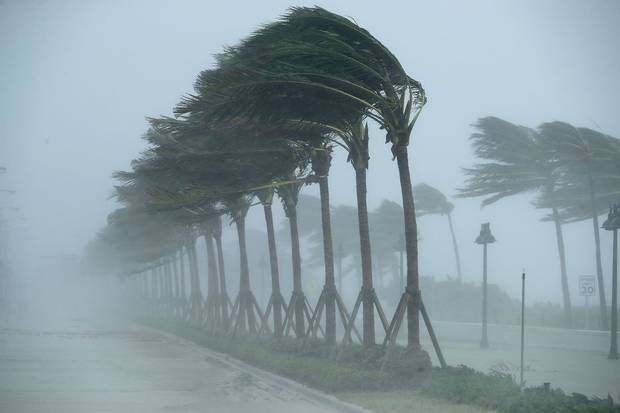The latest
- Florida residents drifted back from shelters and far-away havens Tuesday to see Hurricane Irma’s scattershot destruction. Flooded streets remained, and the count of damaged and totalled homes ticked upward even as some curfews were lifted and flights resumed.
- Damage to communities like Tampa and Miami wasn’t as bad as predicted because of a last-minute change of course: The storm had been expected to hit Florida’s east coast at full strength, but it instead it went west, strafing the other side of the peninsula with less force and causing less extensive (though still severe) flooding.
- Irma was still a deadly disaster, in Florida as elsewhere in its path. As of Wednesday, Irma was responsible for 18 deaths in the southeastern United States and 43 in the Caribbean.
- “We’ve got a lot of work to do, but everybody’s going to come together,” Florida Governor Rick Scott said Tuesday. “We’re going to get this state rebuilt.”
- The number of people without electricity in the steamy late-summer heat dropped on Wednesday to 9.5 million, just under half of Florida’s population. Earlier in the week, as many as 13 million had been powerless. Utility officials warned it could take 10 days or more for power to be fully restored.
- Ahead of Irma’s arrival, the U.S. Southeast saw one of the largest evacuations in American history, in which nearly seven million people in the Southeast were warned to seek shelter elsewhere, including 6.4 million in Florida alone.
- By the time Irma blows over, insured damages in the United States could be anywhere from $15- to $50-billion, or $20- to $65-billion if the Caribbean damage is included, according to one Sept. 9 estimate by AIR Worldwide.
- Canadians in the U.S. who need help can contact the Washington embassy at 1-844-880-6519.
- The Red Cross and UNICEF are collecting donations for Irma relief.
Video Canada assessing Caribbean aid needs after Hurricane Irma
The flooding in pictures
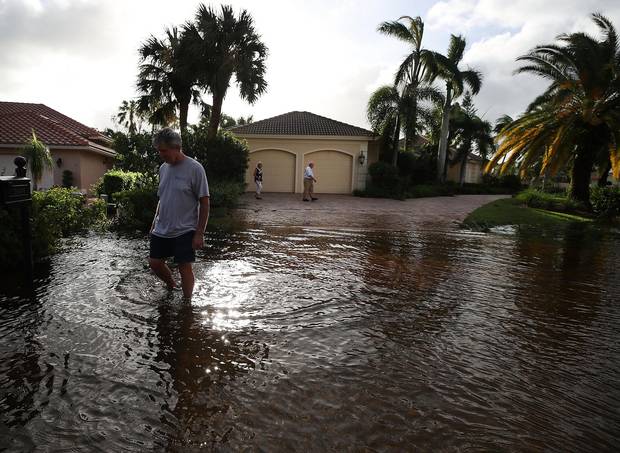
Bonita Springs, Fla., Sept. 11: People inspect their flooded neighborhood.
MARK WILSON/GETTY IMAGES
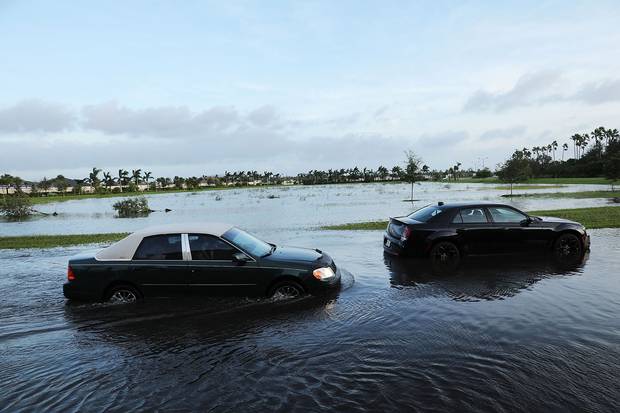
Bonita Springs, Fla., Sept. 11: Cars make their away through a flooded street.
SPENCER PLATT/GETTY IMAGES
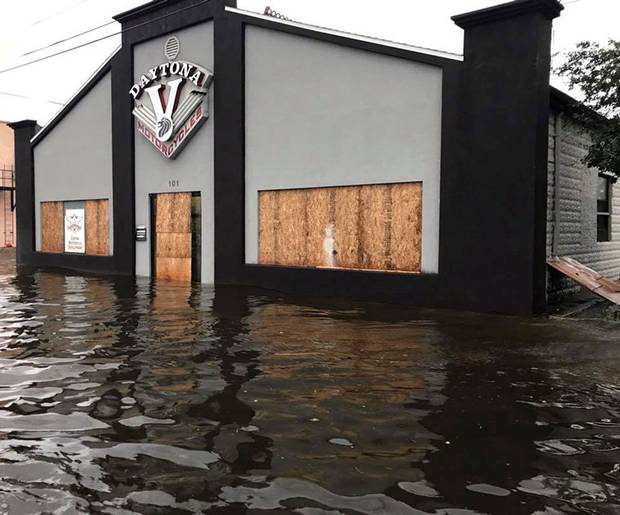
Daytona Beach, Fla., Sept. 11: A boarded-up motorcycle shop stands in flood waters.
DAYTONA BEACH POLICE DEPARTMENT/REUTERS
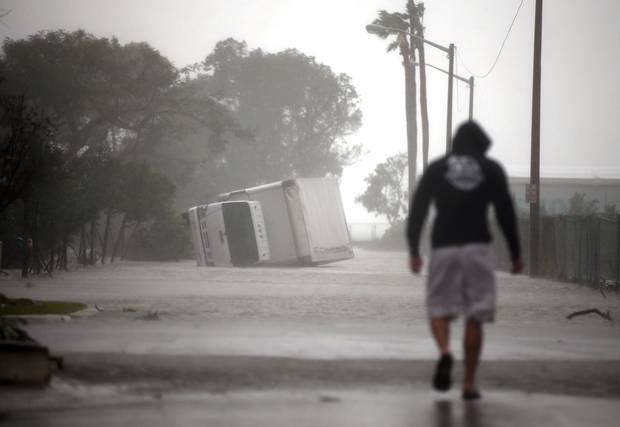
Miami, Sept. 10: A truck is seen turned over.
CARLOS BARRIA/REUTERS
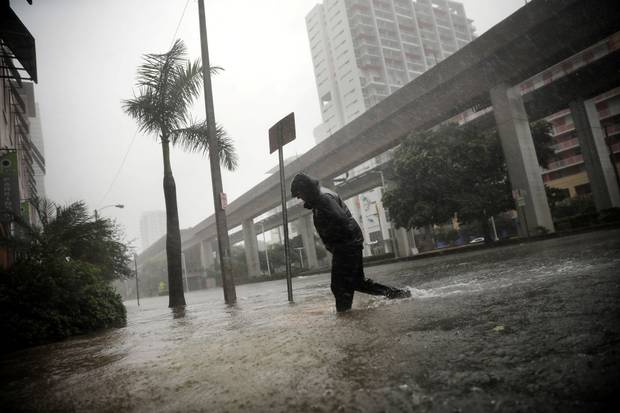
Miami, Sept. 10: A local resident walks across a flooded street.
CARLOS BARRIA/REUTERS
Terrible trio: Wind, storm surge and rain
Hurricanes are one of nature's most powerful engines of destruction, turning warm sea water into wind and rain. Here's a look at how those devastating forces played out in Florida. (For a more detailed primer on how hurricanes form, read more here.)
Wind
To be classified as a hurricane, a tropical storm has to have top wind speeds of 119 kilometres an hour or higher. Irma was going much faster than that, about 215 km/h, when its eyewall – the fast-moving ring of clouds surrounding the centre of the hurricane – made contact with the Florida Keys early Sunday. Technically, a hurricane doesn't have to make landfall to lash a coastal area with its strongest winds, the U.S. National Hurricane Center explains; "landfall" means that the centre of a hurricane has crossed onto a coastline, and the precise centre isn't where the strongest winds are.
@SimonStormRider getting wind measurements out in the eyewall as well. Got a 117 mph wind gust. pic.twitter.com/PVEPP8FbtB
— Juston Drake (@JustonStrmRider) September 10, 2017
Past the 119-km/h threshold, the U.S. hurricane centre classifies storms in five categories of wind speed. Irma spent much of its Caribbean journey as a Category 5, the highest and open-ended category, which has winds fast enough to destroy most houses. But when it arrived in Florida it was a Category 4, still destructive enough to damage houses and topple trees and power lines.

TRISH McALASTER/THE GLOBE AND MAIL (SOURCE: NHC, NOAA.GOV)

Irma's winds, Aug. 30 - Sept. 11
Hurricane force winds
Tropical storm force winds
Atlantic Ocean
U.S.
S.C.
Ga.
Ala.
Atlantic Ocean
Fla.
THE BAHAMAS
TURKS
AND CAICOS
LEEWARD
ISLANDS
CUBA
HAITI
DOMINICAN
REPUBLIC
PUERTO
RICO
THE GLOBE AND MAIL, SOURCE:
NATIONAL HURRICANE CENTRE

Irma's winds, Aug. 30 - Sept. 11
Tropical storm force winds
Hurricane force winds
Atlantic Ocean
Atlantic Ocean
U.S.
S.C.
Ga.
Ala.
Atlantic Ocean
Fla.
THE BAHAMAS
TURKS
AND CAICOS
LEEWARD
ISLANDS
CUBA
HAITI
DOMINICAN
REPUBLIC
PUERTO
RICO
THE GLOBE AND MAIL, SOURCE: NATIONAL HURRICANE CENTRE

Irma's winds, Aug. 30 - Sept. 11
Tropical storm force winds
Hurricane force winds
U.S.
S.C.
Atlantic Ocean
Ga.
Ala.
Atlantic Ocean
Fla.
THE BAHAMAS
TURKS
AND CAICOS
LEEWARD
ISLANDS
CUBA
HAITI
DOMINICAN
REPUBLIC
PUERTO
RICO
THE GLOBE AND MAIL, SOURCE: NATIONAL HURRICANE CENTRE
Irma lost and gained speed several times over the weekend as it hit land, went out to sea again and regained strength from warm ocean waters. By early Monday it was a Category 1 and then a tropical storm (defined as a storm of 63 to 118 km/h); by Tuesday, its weakened remnants were raining down on Georgia and Alabama.

Hurricane Irma, as of Monday,
Sept. 11, 5 a.m. ET
Hurricane centre location
Potential track area
Hurricane/tropical storm warning
U.S.
0
500
Tenn.
KM
S.C.
Ga.
Miss.
Ala.
Fla.
Gulf of Mexico
Probability of
tropical-storm-force winds
1-minute average 63 km/h or over
5
20
40
60
80%
THE GLOBE AND MAIL, SOURCE:
NATIONAL HURRICANE CENTRE

Hurricane Irma, as of Monday, Sept. 11, 5 a.m. ET
Hurricane centre location
Potential track area
Hurricane/tropical storm warning
U.S.
0
500
Tenn.
KM
S.C.
Ga.
Miss.
Ala.
Fla.
Gulf of Mexico
Probability of
tropical-storm-force winds
1-minute average 63 km/h or over
5
20
40
60
80%
THE GLOBE AND MAIL, SOURCE: NATIONAL HURRICANE CENTRE

Hurricane Irma, as of Monday, Sept. 11, 5 a.m. ET
Hurricane centre location
Potential track area
Hurricane/tropical storm warning
U.S.
0
500
Tenn.
KM
S.C.
Ga.
Miss.
Ala.
Fla.
Gulf of Mexico
Probability of tropical-storm-force winds
1-minute average 63 km/h or over
5
20
40
60
80%
THE GLOBE AND MAIL, SOURCE: NATIONAL HURRICANE CENTRE
Storm surge
A tropical cyclone is essentially a giant vaccuum of swirling water vapour, and the more powerful it is, the more water it sucks from some parts of the ocean to move to others. At one end, this creates astonishing drops in the water level, leaving boats and marine life stranded on exposed ocean floor …
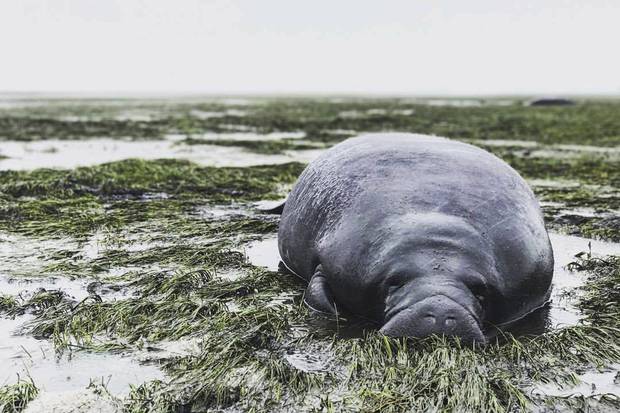
Manatee County, Fla., Sept. 10: A manatee lies stranded after waters receded from the bay.
MICHAEL SECHLER/VIA ASSOCIATED PRESS
… and at the other end, it creates storm surges, flooding streets and homes. In the low-lying Florida Keys, storm surges of three metres (10 feet) were reported, sinking boats an washing away appliances and furniture.
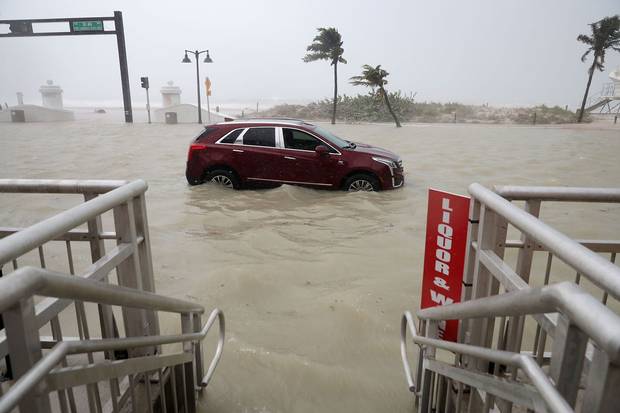
Fort Lauderdale, Fla., Sept. 10: A car sits abandoned in storm surge.
CHIP SOMODEVILLA/GETTY IMAGES
But communities north of Fort Myers, Sarasota and Tampa Bay, which had been expecting heavy storm surge, caught a lucky break: The storm's change of course to Florida's west coast spared the east from more powerful surges. Had Irma lingered far enough off Florida's Gulf Coast, its eastern wall, where the strongest winds occur, could have shoved six to nine feet of water into parts of Fort Myers and Naples, while swamping Tampa Bay and St. Petersburg as well. But hurricanes turn counterclockwise, so when the storm tracked west and then north over Naples, Fort Myers and Tampa Bay, the winds at the head of the storm were moving west and actually pulling water away from the shoreline. Then, once the eye of the hurricane had passed through those areas, the back side of the storm hit, pulling water east toward the coast – but by this point, the storm's winds were weakening, and the resulting surge was not nearly as strong as feared.
Rain
As Irma continues to pour down water on Florida, then Georgia and Alabama, it remains to be seen how bad the flooding will get. Houston's flood damage from Hurricane Harvey last month was made worse when the storm stalled over Texas for days, dumping 33 trillion gallons of water on U.S. soil by Sept. 1.
What Floridians are doing
Irma's impending arrival triggered one of the biggest evacuations in U.S. history: Some seven million, 6.4 in Florida, were ordered to leave.
The state had already spent $77-million ahead of Irma's arrival, calling up 7,000 National Guard across the state. Officials set aside 3.2 million litres of water, filled 67 trailers with meals, and amassed 24,000 tarps. They also have asked the federal government to kick in 11 million meals and millions more litres of water.
The challenges in the immediate aftermath of the storm will be many: Restoring across the state, removing debris from roads, dealing with possible fuel shortages and making sure nursing home and hospital patients who were evacuated can safely return. State officials are also fearful the massive rain that was soaking the state could also lead to flash floods.
A weary Florida Governor Rick Scott, who has flown across the state during the past five days sounding the alarm bell ahead of landfall, acknowledged Sunday that it won't be easy for residents in the days ahead. "I don't think anybody alive today in this state has ever seen anything like this," he said.
How much will it cost to clean this up?
Florida's west coast has about $1-trillion (U.S.) in property at risk to a storm, compared with $1.5-trillion on the east, according to insurance computer modeling firm AIR Worldwide. The company estimates insured losses for Irma will be between $15-billion and $50-billion. That's probably less expensive than Hurricane Harvey, which could cost $50- to $75-billion, according to Moody's Analytics.
Jeff Masters, meteorology director for Weather Underground, told Associated Press that when Irma is done it will likely go down as one of the five costliest hurricanes in U.S. history, but not up with the top three of 2005's Hurricane Katrina, 2012's Sandy and this year's Harvey. Still, he guessed, it will be grouped with two other South Florida storms: 1992's Andrew and 2005's Wilma.
The hurricane's exact toll may be hard to assess because insurers are scrambling to find enough inspectors in Texas and Florida. "The one-two punch of Harvey and Irma is no question challenging to the industry," Kenneth Tolson, who heads the U.S. property and casualty division of Crawford & Co., which provides claims adjusters and staff after disasters, told Reuters.
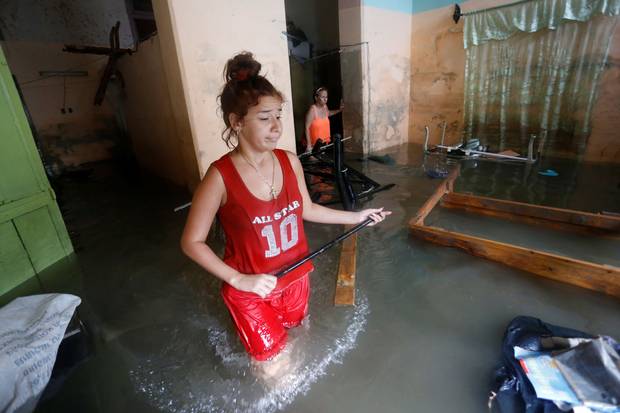
Havana, Sept. 10: A woman reacts while wading through her flooded home after Irma’s passing.
REUTERS
The Caribbean catastrophe
As hard-hit as Florida was, the Caribbean saw far more widespread devastation from Irma, which aid agencies are now struggling to cope with now that repaired ports and clearer weather are reconnecting the devastated islands with the outside world.
At least 24 people died in Anguilla, Barbuda, the French-Dutch island of St. Martin, St. Barts, the U.S. Virgin Islands and the British Virgin Islands. Residents have reported shortages of food, water and medicine, and many have complained of looting.
Also hit hard was Cuba, where central Havana neighbourhoods along the coast between the Almendares River and the harbour suffered the brunt of the flooding. Seawater penetrated as much as a half-kilometre inland in places. There were no reported fatalities in Cuba, and government officials credited their disaster preparedness and evacuation of more than one million people from flood-prone areas.
Here's a more detailed primeron the Caribbean nations affected by Irma and the scale of the damage caused.
What Canada is doing
On Sunday, the Canadian government announced it would be deploying an assessment team to Antigua to see what could be done to help victims of the hurricane. One option Canada can choose is to use is its Disaster Assistance Response Team, made up of members of the military and civilians from Global Affairs Canada, which can go to anywhere in the world on short notice to provide humanitarian assistance.
Canadian Disaster Assessment Team will deploy to Antigua to assess how Canada can provide relief + assistance in the region. #HurricaneIrma
— Harjit Sajjan (@HarjitSajjan) September 10, 2017
What you can do
The Red Cross is collecting donations for Irma relief, while UNICEF's fund will be focused on helping children.
With reports from The New York Times News Service, Reuters and Globe staff
THE COMING STORMS: MORE FROM THE GLOBE AND MAIL
